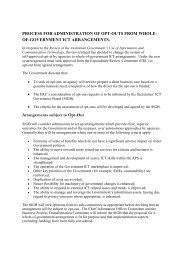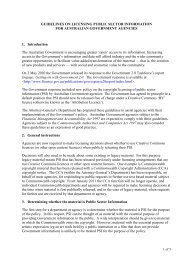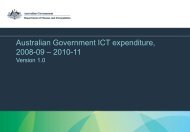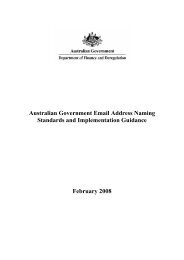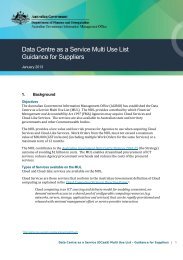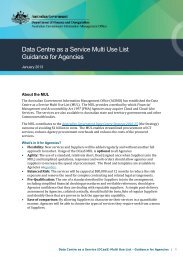Big Data Strategy â Issues Paper - About AGIMO
Big Data Strategy â Issues Paper - About AGIMO
Big Data Strategy â Issues Paper - About AGIMO
You also want an ePaper? Increase the reach of your titles
YUMPU automatically turns print PDFs into web optimized ePapers that Google loves.
Contents1. Introduction 31.1 Where are we now? 31.2 Why a big data strategy? 42. Opportunities for Australian Government agencies 52.1 What the future looks like 63. Challenges 73.1 Privacy, security and trust 73.2 <strong>Data</strong> management and sharing 83.3 Technology and analytical systems 93.4 Skills 104. The Way Forward 115. Endnotes 12This publication is protected by copyright owned by the Commonwealth of Australia.With the exception of the Commonwealth Coat of Arms and the Department of Finance andDeregulation logo, all material presented in this publication is provided under a Creative CommonsAttribution 3.0 licence. A summary of the licence terms is available on the Creative Commons website.Attribution: Except where otherwise noted, any reference to, use or distribution of all or part of thispublication must include the following attribution:<strong>Big</strong> <strong>Data</strong> <strong>Strategy</strong> — <strong>Issues</strong> <strong>Paper</strong>, © Commonwealth of Australia 2013.Use of the Coat of Arms: The terms under which the Coat of Arms can be used are detailed on the It'san Honour website.Contact us: Inquiries about the licence and any use of this publication can be sent toictpolicy@finance.gov.au.
1. IntroductionThe data held by Australian Government agencies is both a national and governmentasset. It is also a potential source of opportunity. In this context, AustralianGovernment agencies, like many other organisations, are aware of the challengesand opportunities that big data represents to the way they develop policy anddeliver services to citizens.The purpose of this issues paper is to provide an opportunity to consider the rangeof opportunities presented to agencies in relation to the use of big data, and theemerging tools that allow us to better appreciate what it tells us, in the context ofthe potential concerns that this might raise.As an example, one of the major challenges facing agencies here is to leverage thevalue of big data sets while ensuring they continue to protect the privacy rights ofthe Australian public.The Australian Government is committed to protecting citizen’s rights to privacy,and as part of that commitment, has recently strengthened the provisions of thePrivacy Act. The Australian Government Management Information ManagementOffice (<strong>AGIMO</strong>) acknowledges that big data, and its associated analytical tools, canprovide a challenge to these rights, but believe that, with proper considerations,agencies will be able to use big data to develop better policies and deliver betterservices without compromising the privacy rights of the public.Our aim is to ensure that the use of the new technology and tools supporting bigdata will deliver benefits while maintaining compliance with privacy. To this end<strong>AGIMO</strong> will be working closely with the Office of the Australian InformationCommissioner (OAIC), the Attorney General’s Department (AGD) and experts acrossthe public and private sectors as it develops a big data strategy.1.1 Where are we now?<strong>Data</strong> is being produced at an ever increasing rate. This growth in data production isbeing driven by:individuals and their increased use of media;organisations;the switch from analogue to digital technologies; andthe proliferation of internet connected devices and systems.There has also been an acceleration in the proportion of machine-generated andunstructured data (photos , videos, social media feeds and so on) compared tostructured data such that 80% or more of all data holdings are now unstructuredand new approaches and technologies are required to access, link, manage and gaininsight from these data sets.The commonly accepted definition of big data comes from Gartner who define it ashigh-volume, high-velocity and/or high-variety information assets that demand<strong>Big</strong> <strong>Data</strong> <strong>Strategy</strong> — <strong>Issues</strong> <strong>Paper</strong> | 3
2. Opportunities for AustralianGovernment agenciesThe opportunity that big data presents to government agencies is in the potential tounlock the value and insight contained in the data agencies already hold via thetransformation of information, facts, relationships and indicators. The value of bigdata for agencies is limited by the their ability to effectively manage the volume,velocity and variety of big data and the ability to derive useful information from thisdata. With every opportunity there come challenges or barriers and agencies mustovercome these to enable the benefits of big data to be realised.Consideration of advances in big data technology has shown that it has potential toenhance the government’s analysis capability in areas such citizen-centric servicedelivery. It is evident that big data also provides insights into social networks andrelationships as well as allowing for the development of predictive models for anumber of applications.Of interest more broadly to agencies, big data analysis may provide profoundinsights into a number of key areas of society including health care, medical andother sciences, transport and infrastructure, education, communication,meteorology and social sciences.Key areas that big data analytics may influence are detailed below:<strong>Data</strong> management — there are potential savings in time and money if agenciesimplemented smarter data management practices that were conscious of the needsof big data analysis. <strong>Data</strong> sources from differing organisations and operational areaswould be of greater benefit to multiple agencies and for multiple purposes if therewere greater transparency. For example, through better business processmanagement, redundant data collection processes can be reduced by reusing datacollected from separate processes.Personalisation of services — big data analytics may produce value by revealing aclear picture of an individual customer or customer group. <strong>Big</strong> data is able toachieve this due to its characteristic granularity (its ability to combine multiple anddiffering small pieces of data to generate revealing insights). This granularity mayassist in unlocking the possibility of personalised services tailored to the individualand delivered by government.Problem solving and predictive analytics — the unification of multiple datasetsfrom disparate sources in combination with advanced analytics techniques andtechnologies will advance problem solving capabilities, and in turn will improve theability of predictive analytics to reveal insights that can effectively support decisionmaking.Productivity and efficiency — the analysis of big data sources can be used toidentify cost savings and opportunities to increase efficiency, which will directly<strong>Big</strong> <strong>Data</strong> <strong>Strategy</strong> — <strong>Issues</strong> <strong>Paper</strong> | 5
contribute to an improvement in productivity. This can in turn help to encouragefurther innovation.2.1 What the future looks likeA successful big data strategy is expected to assist in realising each of the priorityareas observed in the ICT <strong>Strategy</strong>.The delivery of better services — big data analytics will allow governmentagencies to deliver more personalised services that are tailored to meet citizen’sneeds and preferences. For example, the identification of individuals or groups whoare eligible for certain entitlements without the need for them to be aware of orexplicitly apply for that benefit.Improved efficiency of government operations — more effective use of big datafor predictive analysis will allow government agencies to better assess risk andfeasibility, and detect fraud and error. This will in turn deliver improvedproductivity as resources can be directed towards projects with greater confidenceof the outcome.Open engagement — through the <strong>Big</strong> <strong>Data</strong> Working Group and other groups suchas the Australian Tax Office’s <strong>Data</strong> Analytics Centre of Excellence, agencystakeholders in big data and its related technologies will be able to engage withindustry, academia, non-government organisations and other interested partieslocally and internationally. These engagements will help to build knowledge, sparkideas, generate growth and better inform decisions and solutions that meet theneeds of the government, both on a national and local level.Further to this, the pursuit of big data technologies by government agencies will seea number of potential collaboration opportunities between agencies that willstrengthen existing networks and help develop new partnerships.<strong>Big</strong> <strong>Data</strong> <strong>Strategy</strong> — <strong>Issues</strong> <strong>Paper</strong> | 6
3. ChallengesMeeting the challenges presented by big data will be difficult. The volume of data isalready enormous and increasing every day. The velocity of its generation andgrowth is increasing, driven in part by the proliferation of internet connecteddevices. Furthermore, the variety of data being generated is also expanding, andorganisation’s capability to capture and process this data is limited.Current technology, architecture, management and analysis approaches are unableto cope with the flood of data, and organisations will need to change the way theythink about, plan, govern, manage, process and report on data to realise thepotential of big data.3.1 Privacy, security and trustThe Australian Government is committed to protecting the privacy rights of itscitizens and has recently strengthened the Privacy Act (through the passing of thePrivacy Amendment (Enhancing Privacy Protection) Bill 2012) to enhance theprotection of and set clearer boundaries for usage of personal information.Government agencies, when collecting or managing citizens data, are subject to arange of legislative controls, and must comply with the a number of acts andregulations such as the Freedom of Information Act (1982), the Archives Act (1983),the Telecommunications Act (1997) ,the Electronic Transactions Act (1999), and theIntelligence Services Act (2001). These legislative instruments are designed tomaintain public confidence in the government as an effective and secure repositoryand steward of citizen information.The use of big data by government agencies will not change this; rather it may addan additional layer of complexity in terms of managing information security risks.<strong>Big</strong> data sources, the transport and delivery systems within and across agencies, andthe end points for this data will all become targets of interest for hackers, both localand international and will need to be protected.The public release of large machine-readable data sets, as part of the opengovernment policy, could potentially provide an opportunity for unfriendly stateand non-state actors to glean sensitive information, or create a mosaic of exploitableinformation from apparently innocuous data. This threat will need to be understoodand carefully managed.The potential value of big data is a function of the number of relevant, disparatedatasets that can be linked and analysed to reveal new patterns, trends and insights.Public trust in government agencies is required before citizens will be able tounderstand that such linking and analysis can take place while preserving theprivacy rights of individuals.<strong>Big</strong> <strong>Data</strong> <strong>Strategy</strong> — <strong>Issues</strong> <strong>Paper</strong> | 7
The public trust in government agencies and systems needs to be maintained. As thevolume of government data holdings increase, the trust that Australians have inthese agencies and their ability to securely hold information of a personal naturecan easily be affected by leakage of data or information into the public domain.Agencies need to be able to maintain the public’s trust and will need to consider thisissue at the forefront when developing secure systems for managing big data stores.Liaison with industry experts is an important first step in this process.3.2 <strong>Data</strong> management and sharingAccessible information is the lifeblood of a robust democracy and a productiveeconomy. 2 Government agencies realise that for data to have any value it needs tobe discoverable, accessible and usable, and the significance of these requirementsonly increases as the discussion turns towards big data.Government agencies must achieve these requirements whilst still adhering toprivacy laws. The processes surrounding the way data is collected, handled, utilisedand managed by agencies will need to be aligned with all relevant legislative andregulatory instruments with a focus on making the data available for analysis in alawful, controlled and meaningful way.<strong>Data</strong> also needs to be accurate, complete and timely if it is to be used to supportcomplex analysis and decision making. For these reasons, management andgovernance focus needs to be on making data open and available across governmentvia standardised APIs, formats and metadata. Improved quality of data will producetangible benefits in terms of business intelligence, decision making, sustainable costsavingsand productivity improvements.The current trend towards open data and open government has seen a focus onmaking data sets available to the public, however these ‘open’ initiatives need toalso put focus on making data open, available and standardised within and betweenagencies in such a way that allows inter-governmental agency use and collaborationto the extent made possible by the privacy laws.There are opportunities for agencies to create incentives that promote competitionand innovation within the marketplace. Various releases of public sectorinformation (PSI) into public ‘mash-up’ sessions have already seen new andinnovative uses for public data be developed.In order to increase the use of government data across agencies, individual agenciesneed to be encouraged to establish and maintain publically available informationasset registers. Information asset registers are lists of an agencies informationassets intended to increase the discoverability, access and reusability of agencyinformation assets by both internal and external users.The OAIC, in the paper Open Public Sector Information – from Principles to Practice v ,has highlighted that agencies have identified establishing and maintaining aninformation asset register as the largest challenge in ensuring more robustinformation management, and this has been highlighted as a priority action area.The release of PSI also needs to be considered in the light of new technologies thatcan provide an opportunity for unfriendly state and non-state actors to gleansensitive information, or create exploitable information from seemingly innocuousdata sets.<strong>Big</strong> <strong>Data</strong> <strong>Strategy</strong> — <strong>Issues</strong> <strong>Paper</strong> | 8
The National Broadband Network (NBN) will assist in providing the necessarybandwidth to transport the data and may help to enable data to be analysed in acloud environment and in near real-time.Agencies will need to determine the feasibility of any big data analytics projectsbased upon their ability to meet the business needs of the agency rather than anypreconceived technological preference.Vendors and developers of big data systems and solutions, including open sourcesoftware, are developing more capable tools to simplify the challenges of big dataanalysis.3.4 SkillsDue to its relative youth and complexity, big data will require agencies to attractemployees with diverse new skill sets. These skills include science, technological,research, statistical, analytical and interpretive skills, business acumen andcreativity — as well as an understanding of the underlying nature of the businessprocess or policy intent. These skill sets are unlikely to be found in any one person,and this means that collaborative teams of specialists will need to be assembled toallow agencies to achieve optimal results from their data analysis efforts.Many observers have noted that there is currently a major skills gap for datascientists with experience in big data analytics. According to Gartner 4 , by 2015, bigdata demand will reach 4.4 million jobs globally, with two thirds of these positionsremaining unfilled.There is currently a shortage of university degrees that have a curriculum focusedon big data analytics. Industry is looking for more qualified professionals with skillsrelated to big data analytics. There is a push for education providers to developcourses that provide suitable education and training in this area of expertise.Government agencies will look for opportunities to leverage support from theexpertise and experience in big data that is found inside and outside of government.Agencies will also consider opportunities for partnerships with industry (includingvendors and solutions providers) as well as independent research bodies andacademia that will allow agencies to attract, retain and maintain expertise in thisarea much as it does with senior staff across other functional areas of government.The Advanced Analytics Institute (AAI)In Australia, the University of Technology Sydney has opened the AdvancedAnalytics Institute (AAI), a research institute that focuses on data and analyticsscience as well as evidence-driven decision making research. The AAI bringstogether researchers with a variety of backgrounds and aims to support andmentor generations of high-calibre analytics graduates. It has worked with anumber of organisations and Australian Government departments including AMP,IBM, SAS, Microsoft Research, Nokia, Westpac, the ATO and DHS (Centrelink).<strong>Big</strong> <strong>Data</strong> <strong>Strategy</strong> — <strong>Issues</strong> <strong>Paper</strong> | 10
4. The Way ForwardTo realise the outcomes of the ICT <strong>Strategy</strong> in relation to big data, AustralianGovernment agencies need to achieve the following objectives:leveraging the big data experience and skills that exist within a small number ofgovernment agencies, and across the ICT industry and the research communityto address the skills deficit that exists in this area. There are great opportunitiesto use this skill and experience to: improve the management and analysis of the data sets that the governmentholds and improve government operations, policy development and service delivery;ensuring that privacy issues are addressed up front in order to: protect the privacy rights of the Australian public and give agencies clarity around how they can use big data to develop betterpolicies and services; andencouraging the release of public sector information (PSI) consistent with allprivacy and security legislative instruments and guidance.To succeed in these endeavours and finalise a big data strategy, agencies, facilitatedby <strong>AGIMO</strong>, will engage in the following supporting activities:support the work of the cross-agency big data working group through thedevelopment of a detailed work plan for the creation of relevant policy, guidanceand advice;work in collaboration with the Whole-of-Government <strong>Data</strong> Analytics Centre ofExcellence to provide assistance in overcoming skills, analysis and technologicalchallenges;develop specific guidance in response to: the OAIC’s recommendations for agencies in creating information assetregisters; and privacy, security and legislative implications of big data across government.<strong>Big</strong> <strong>Data</strong> <strong>Strategy</strong> — <strong>Issues</strong> <strong>Paper</strong> | 11
5. Endnotes1 Department of Finance and Deregulation, Australian Public Service Informationand Communications Technology <strong>Strategy</strong> 2012-2015,http://agimo.gov.au/ict_strategy_2012_2015/2 Office of the Australian Information Commissioner, Open public sectorinformation: from principles to practice,http://www.oaic.gov.au/publications/reports/Open_public_sector_information_from_principles_to_practice_February2013.pdf3Jaikumar Vijayan, Sidebar: The Mosaic Effect,http://www.computerworld.com/s/article/91109/Sidebar_The_Mosaic_Effect4 Gartner, Gartner Reveals Top Predictions for IT Organisations and Users for 2013and Beyond, http://www.gartner.com/it/page.jsp?id=2211115<strong>Big</strong> <strong>Data</strong> <strong>Strategy</strong> — <strong>Issues</strong> <strong>Paper</strong> | 12



